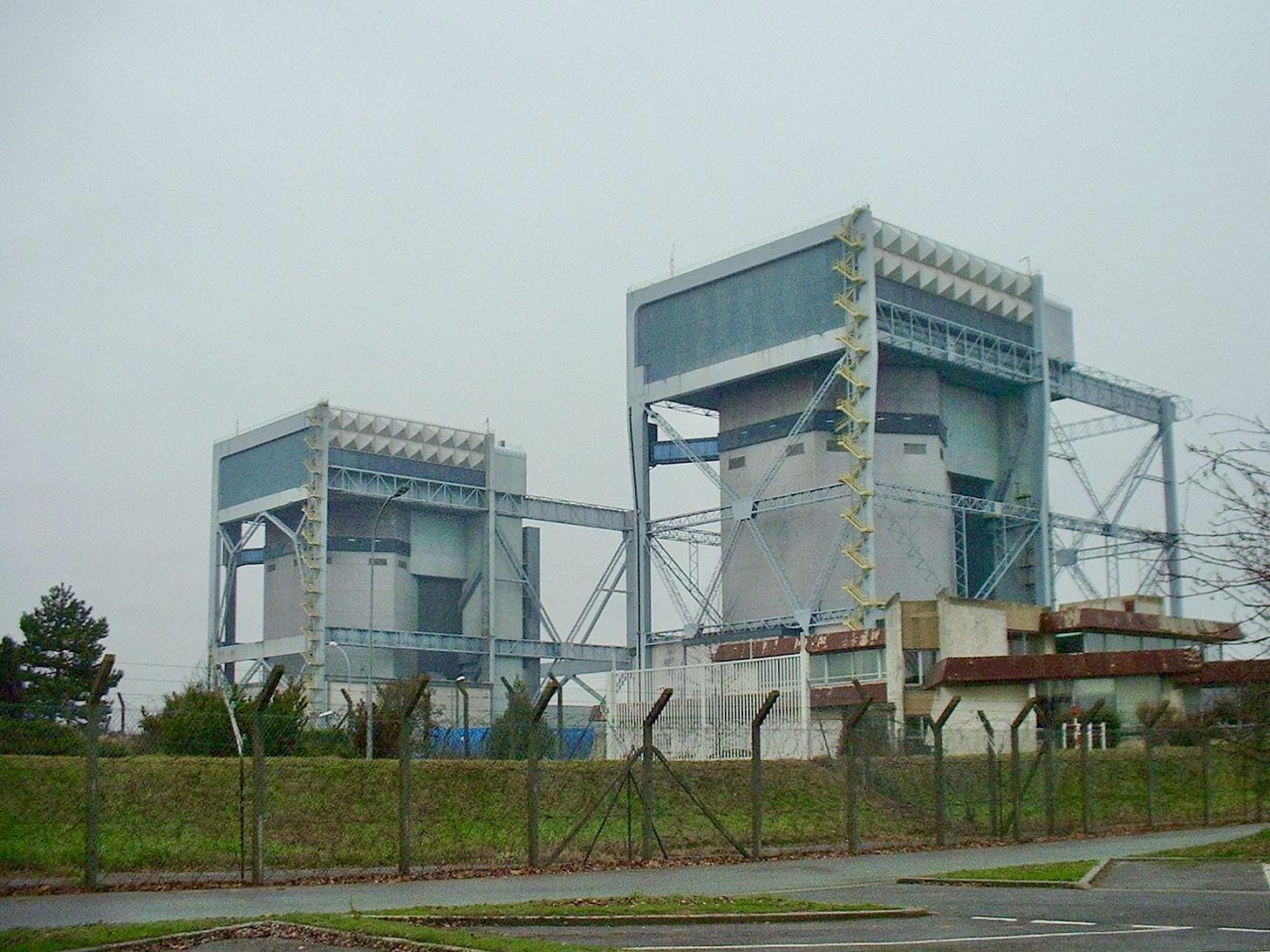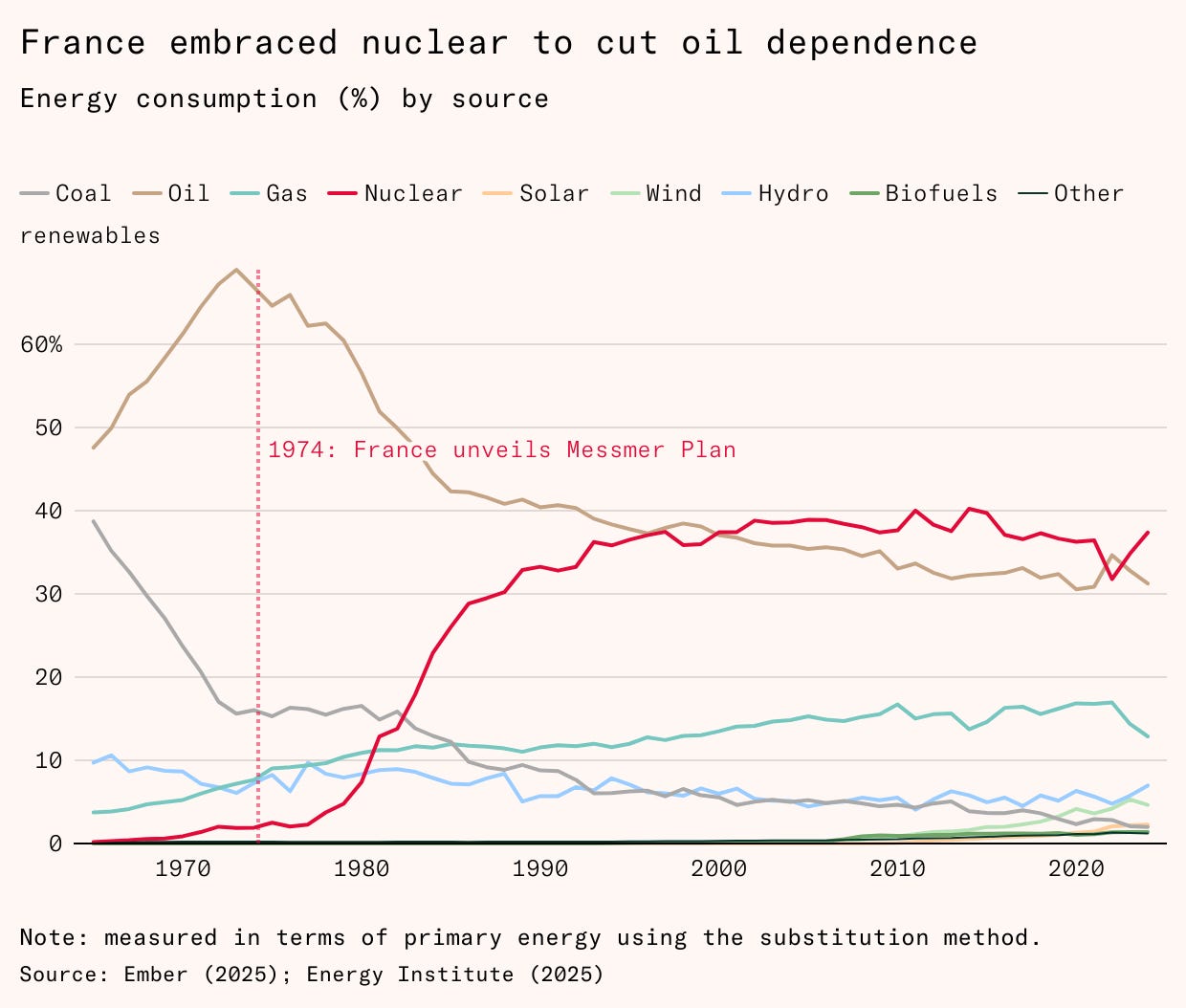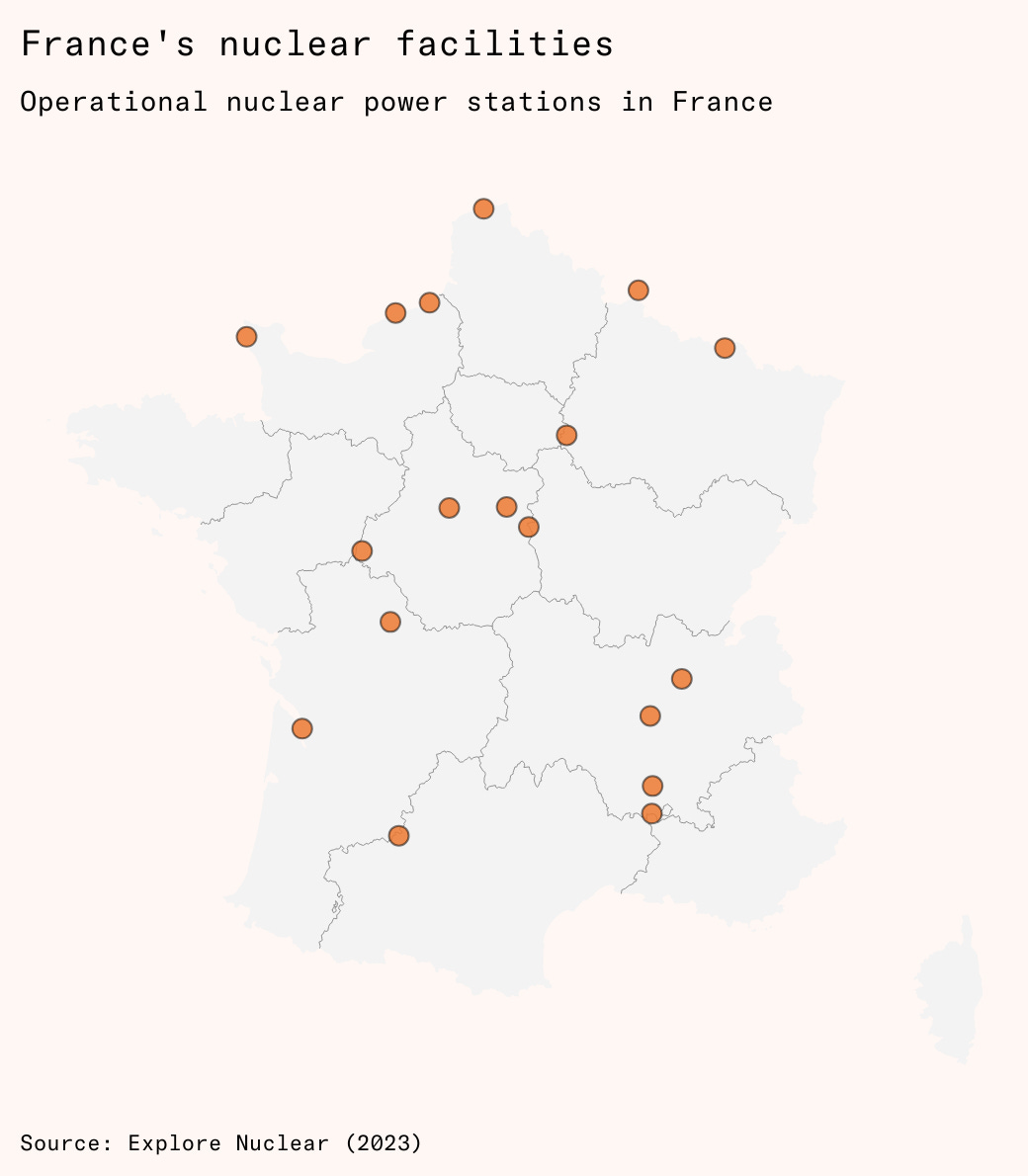Liberté, égalité, radioactivité
France built 40 nuclear reactors in a decade. Here's what the world can learn from it.
In our first article from Issue 20 of Works in Progress, Alex Chalmers outlines how France achieved the world’s fastest ever nuclear buildout.
In the 1970s, the golden age of nuclear energy appeared to be coming to an end. Sharply escalating costs, regulatory upheaval, and public opposition had made industry boasts of electricity ‘too cheap to meter’ seem increasingly hubristic. After peaking in 1973, new US nuclear reactor orders would drop to zero in 1979, despite the oil shocks leading to a doubling of electricity prices in the intervening years. Meanwhile, poor design and planning resulted in the UK’s advanced gas reactor program running 50 percent over budget and years behind schedule.
France stands out as an exception. As much of the world was retrenching, France’s nuclear ambitions were accelerating. The construction of 37 of the 57 reactors currently operating in France began during the 1970s. Today, France has largely decarbonized its grid: 94 percent of French electricity is generated from low-carbon sources, with 70 percentage points of that coming from nuclear power.
France’s success in civilian nuclear power was by no means preordained. Throughout the 1960s, France was a nuclear laggard. Its industry, hamstrung by poor technology choices and institutional infighting, was the subject of domestic and international derision. The program’s eventual success was contingent on a politically courageous about-turn, regulatory focus, and a tax system that made local communities enthusiastic about hosting nuclear power stations.
Inauspicious beginnings
As France embarked on the daunting task of reconstruction after the Second World War, interim leader and Free French hero Charles de Gaulle was set on restoring his country to its preeminent position on the world stage. Before the newly restored French Republic had settled on a constitution, de Gaulle decided that it should have nuclear weapons.
France’s nuclear ambitions were split across two rival entities. The Commissariat à l'Énergie Atomique (CEA), established in 1945, focused on producing plutonium to support the country’s nascent nuclear weapons program. Meanwhile Électricité de France (EDF), created the next year, was in charge of operating France’s electricity grid.
In its early days, EDF was not focused on nuclear energy. It possessed little atomic expertise and had to focus its limited resources on rebuilding and rationalizing the devastated postwar electric grid at the same time as integrating 1,400 newly nationalized electricity companies. This left the CEA to pursue its own choice of reactor design. After some early experimentation, it settled on the gas-graphite design.
This design had two advantages from the CEA’s standpoint. First, it employed natural uranium (uranium-238) at a time when France didn’t have any domestic enrichment facilities. Second, the gas-graphite design didn’t rely on high-pressure systems or sealed fuel assemblies. This meant that individual fuel rods could be easily extracted while the reactor was still running, allowing the operator to harvest the weapons-grade plutonium that the fission reaction produced before it was contaminated with other isotopes.

The CEA finished Marcoule G1, its first full-scale reactor, in 1956. By this stage it had started to work with EDF. The director of EDF’s research division sat on the CEA’s steering committee and had persuaded them to add small power generating units to the Marcoule reactors to capture the heat produced by the reactor and use it to generate electricity. At the same time, this EDF director began to build support within his own organisation to pursue nuclear power.
The resulting reactor, finally completed in 1962, was an unhappy compromise. Deliberately throttled to optimize plutonium enrichment, it generated only about 40 percent of the electricity it was capable of producing (versus 60–70 percent for reactors in other countries at the time and 80–90 percent for reactors today). It provided 11 years of underwhelming performance before being decommissioned in 1973.
EDF1 did not mark the end of the early French nuclear program’s troubles. The unhappy marriage produced two more gas-graphite reactors on the same Chinon site: EDF2 (completed in 1965) and EDF3 (completed in 1966).
In 1965, American company Westinghouse, creator of the pressurized water reactor (PWR), embarked on a global public relations offensive. The Westinghouse sales pitch, which heavily emphasized lower capital costs, found favour with EDF. The company became convinced that the ‘sovereignty’ offered by the use of natural uranium was not worth the inefficiency of gas-graphite plants. A summer of negative press commentary, after the fueling of EDF3 was blighted by technical failures, only reinforced this.
For the next two years, a joint CEA-EDF study committee toured America, poring over designs and spreadsheets. EDF concluded that the pressurized water design would be approximately 20 percent cheaper, even after paying for enrichment. The CEA contested these numbers and dug in their heels. EDF workers also went out on strike in 1969, in defence of the gas-graphite reactor, fearing that the switch to an American design would damage their employment prospects.
It was not until De Gaulle, who was set on an autonomous French design, left the presidency and was replaced by Georges Pompidou that change was possible. In 1970, after persuading the French cabinet and planning commission, EDF began building two pilot pressurized water reactors at Fessenheim, near the German and Swiss borders. EDF had successfully argued that supporting cheap, reliable electricity was more patriotic than building an inefficient all-French reactor. In 1972, after yet another round of technical failures, the government formally ended the gas-graphite program.
In 1973, global oil prices rocketed after a coalition of Arab countries implemented a total embargo against countries that had supported Israel during that year’s Yom Kippur War. Following Algerian independence, France had lost its major source of domestic natural gas production, so it was hit particularly hard. At this time, France met 70 percent of its energy needs through imported oil. By contrast, the UK and West Germany had access to abundant coal deposits, and the British knew that North Sea oil would come onstream from 1975. The US was the world’s biggest oil producer.
In response, France unveiled the Messmer Plan, named after then prime minister Pierre Messmer who was running the country while Pompidou battled with terminal illness. This committed France to a mass buildout of pressurized water reactors. EDF ordered 16 new reactors in 1974, doubling the country’s total reactor order book. Illustrating the improved efficiency, these new reactors had a total output of 14,400 megawatts versus 9,000 megawatts from the previous 16.
The Messmer Plan amounted to the fastest nuclear buildout ever, in both number of reactors built and capacity added. During the 1980s, France increased the number of reactors in commercial operation from 15 to 55. Even China, with the world’s most streamlined regulatory process and developed industrial base, has failed to match this record.
The most striking element of the buildout was speed, with new reactors consistently being built in approximately six years. EDF had a pre-screened list of suitable sites, and reactors were ordered in bulk with a standardized design. This removed the need for a convoluted site licensing process. Meanwhile, safety standards were set in near-total secrecy through a ‘technical dialog’ process between EDF, the CEA, and other government experts, dubbed ‘French cooking’ by Anglo-American observers. Before 1979, EDF was not even required to conduct an environmental impact assessment on individual construction sites.
Long-term planning gave suppliers the certainty they needed to build out teams and production lines. If engineers came up with potential improvements, they were noted and saved for a potential future reactor series, but EDF only made the smallest of changes to designs once they had been approved.
Framatome, a Franco-American consortium responsible for licensing Westinghouse’s technology, was responsible for much of the plant’s manufacture, but EDF wasn’t a passive customer. EDF maintained control of the engineering, much to Framatome’s irritation, and ran a rigorous cost control regime to compensate for the lack of traditional competition.
This rigorous standardization and long-term order book helped create a specialized supply chain, which introduced significant efficiencies into the manufacturing process. Framatome, for example, could invest in a specialized heavy component facility that could produce vessels, steam generators, pressurizers, and piping. The Saint-Marcel facility, opened in 1975, could use spare capacity for exports and has provided components for 106 reactors. They also built a 9,000-ton hydraulic forging press that produced four to five identical pressure-vessel shells per year.
In the 1970s, France was building nuclear reactors at one third to a half of the pre-interest costs that new reactors in the US had risen to amid toughening environmental and safety regulations.
This is an excerpt from a new article on Works in Progress. Continue reading it here.






Alex, any good book you’d recommend on France’s post WWII energy/nuclear strategy?